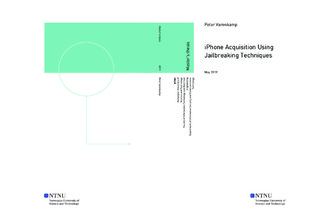| dc.description.abstract | Abstract
Varenkamp
Digital devices are a part of most peoples lives today. Using digital devices leaves traces. These
traces can be urgent to solve a criminal case. Knowing this, forensic work has the goal to get as
much data from a device as possible. Only physical image from a data storage is a 100% copy
and can make sure that all data has been secured.
Forensic work with digital evidence was in the first time done with opening a personal computer,
removing the hard disk and secure with write protection. It was not so difficult to connect
directly to the interface of the hard drive and performing a physical image.
That changed with the first smart phones that were not produced with data storage that could be
removed without a high technical effort. The smart phones used data storage that had not their
own interface and were soldered with the logic board.
In computer forensic investigations the fast technological changes make it more difficult to get
all or most digital data in the same way we did before. One reason is that manufacturers produce
more secured devices as the customer demands it. Another reason may be to make the system
more stable. On the other hand, we will always search how we can get all digital information
from the device as possible, especial erased data that may be urgent for the case.
Apples iPhone is one of the most popular smart phones and has about 14 percent market share
in first quarter of 2018. Only Samsung sells more smartphones with 20 percent market share
at the same time. The most sold smart phones work with different distributions of Android and
had actually a market share up to 85 percent (BusinessReport, 2018).
Apple has continued improving the security mechanism of its products. This fact makes it more
difficult or impossible to get access to the iPhones and extract all information that were stored
on it. Commercial Forensic Software work sometimes with own programs that use security
breaches to get deeper access to a device. Jailbreaking is not offered from commercial vendors.
But they describe their programs are able to extract more data from a jailbroken device.
The aim of my master thesis is to answer the question if iPhones acquisition using jailbreak
techniques can be a forensic way? To answer the research question, five depending sub question
were answered. At the time I began working at the master thesis in middle 2018, I have
first to answer if there is a way for jailbreaking with a current iOS (apples operating system),
that was 10 and 11? Otherwise, it wouldn’t have any sense to continue with my research. Fortunately,
the answer to this question was yes. During writing this master thesis, I have to change
and revise some parts multiple times to be up to date. Reasons have been that new jailbreaks,
new iOS-versions and new iPhones released in this time. | |
